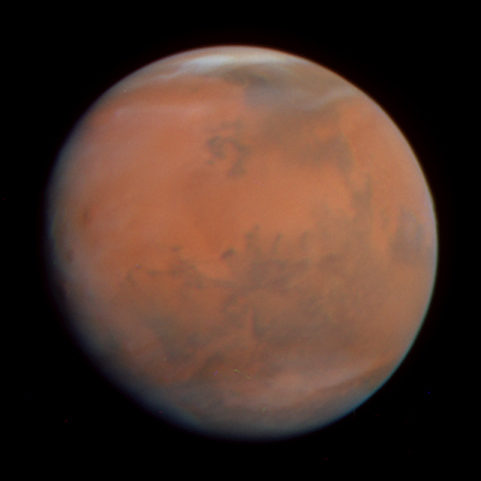Emily Lakdawalla • Feb 02, 2009
A pretty new Hubble image of Mars
I just got an email from Ted Stryk letting me know that a set of Mars image data taken by the Hubble Space Telescope a year ago was just released to Hubble's data archive. Ted produced this approximate true color image of Mars, captured by Hubble's Wide Field and Planetary Camera 2 on January 30, 2008 when Mars was about 115 million kilometers from Earth; the two planets were relatively close, as Earth had just passed by Mars on its faster inner track around the Sun a month before. It was spring in the northern hemisphere, and Phoenix was in flight, on its way to a north polar landing four months later.

Hubble images occupy a curious middle ground between the Mars that humans can see with their telescopes and the Mars visible to orbiting spacecraft. Mostly, you see areas of brighter red and darker purplish color, the classically named albedo markings. Occupying the upper left quadrant is the bright red of Tharsis, and at upper center and right is the dark blob of Acidalia. Below Acidalia, a bright extension from the Tharsis region is Chryse planitia, where both Viking 1 and Pathfinder landed. Below that, at the center of the disk, is a darker region made of Solis Lacus at left, Aurorae sinus at center, and on the right-hand edge of the disk, Sinus Meridiani, where Opportunity still roves. A bright blob called Argyre is at the bottom of the disk, and over all of it is printed wispy white clouds, made of water vapor.
But Hubble can see some of the details first revealed to us by orbiters. At the left you can see the three Tharsis montes poking up as dark spots rising through the high cloud. To the east of them, at the center of the disk, you can just see the distinctive equatorial stripe of Valles Marineris.
Planetary astronomers often use Hubble to take photos of the planets (particularly the nearer ones, Mars, Jupiter, and Saturn) every time there is a conjunction, when Earth and another planet line up on the same side of the Sun, so that the distance between Hubble and the planet is at a minimum. But there was another reason to take these photos, which I explained at length in this post: on that date, a tiny near-Earth asteroid called 2007 WD5 was making a very close approach to Mars, and had briefly been considered an impact risk for the Red Planet. The images were taken in an effort to spot WD5, and if the imaging were successful, it would allow astronomers to determine the course of the asteroid past Mars, which would, in turn, allow them to calculate its future path. Without pretty good knowledge of WD5's position with respect to Mars, it'll be impossible to find it again, as Mars' gravity probably shifted its orbit by quite a lot. Ted said he couldn't find WD5 in the photos right off the bat, but would keep looking!
And speaking of Mars, don't miss A. J. S. Rayl's latest monthly update on the status of the rovers.
Support our core enterprises
Your support powers our mission to explore worlds, find life, and defend Earth. You make all the difference when you make a gift. Give today!
Donate

 Explore Worlds
Explore Worlds Find Life
Find Life Defend Earth
Defend Earth

